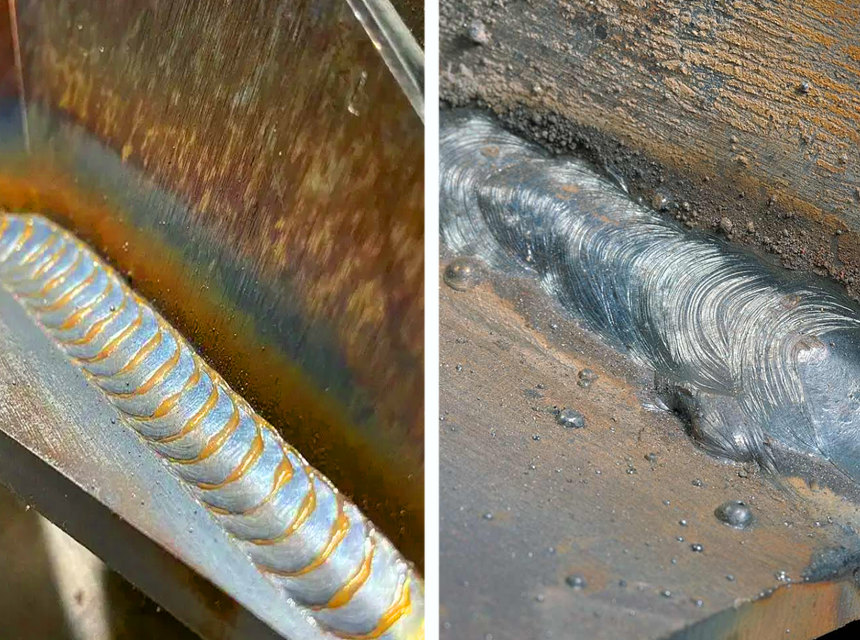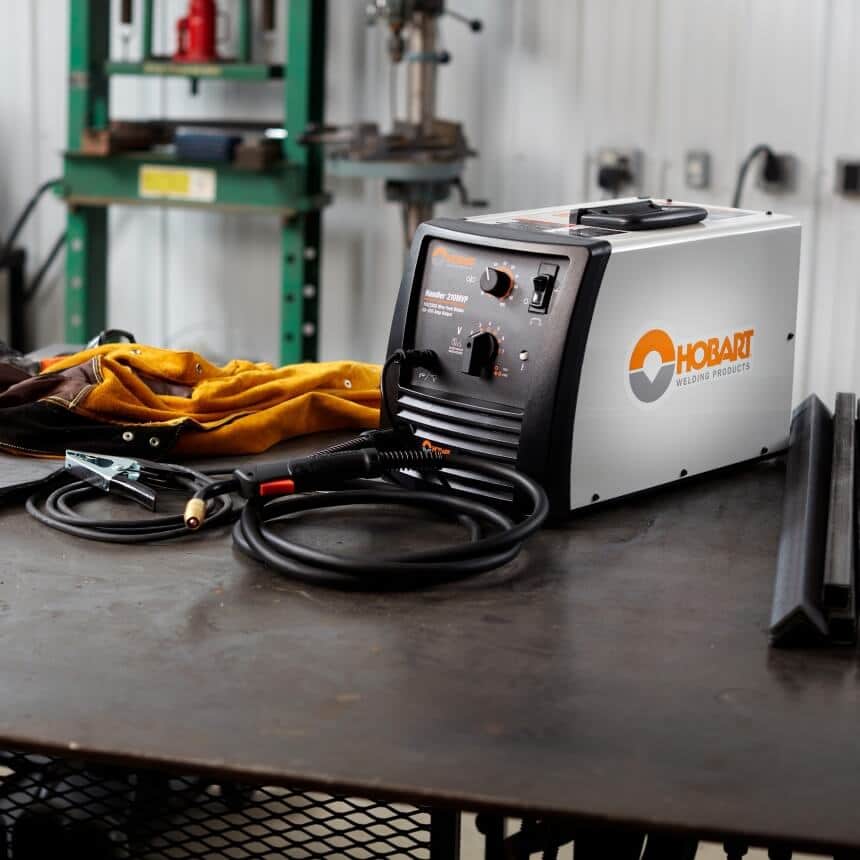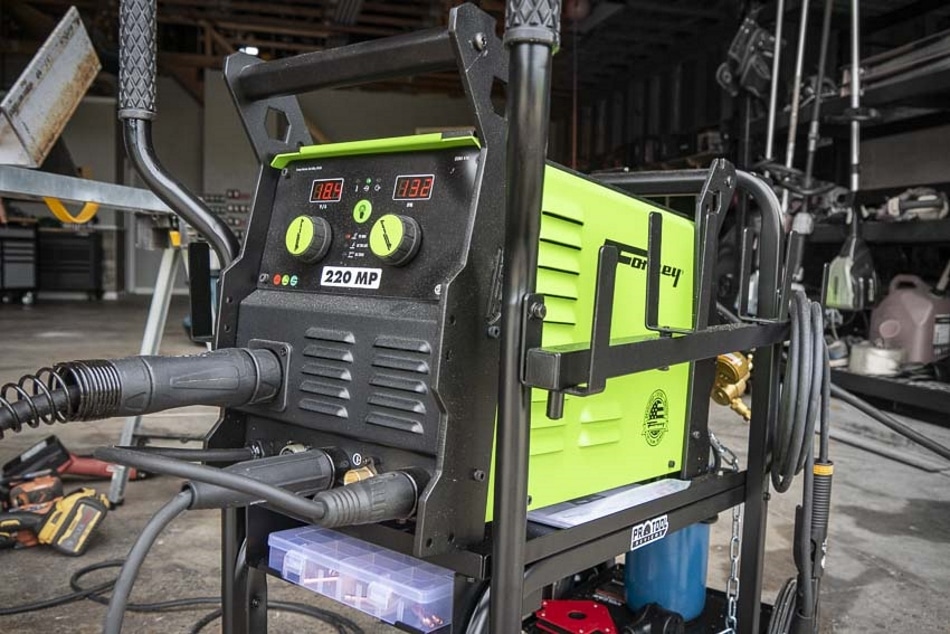There are many benefits to using plasma cutting over other methods of cutting metal. Plasma cutters can cut through metal quickly and accurately. They can also create clean, precise cuts. Plasma cutters can be used to create complex shapes and designs, and they can be used to cut through metal of all thicknesses.
When shopping for the best plasma cutter under $500, you should expect to find a machine that’s powerful enough to cut most materials, including thicker metals. You should also look for a machine that’s easy to use and comes with features like automatic operation that make the cutting process simpler and more efficient. After reviewing 34 different models we came up with a list of top 8 picks, where the Lotos LTP5000D deserved our Editor’s Choice nomination.
More features: power supply and torch included; no assembly required; 1-year warranty; non-touch Pilot RC; compact
The Lotos LTP5000D won our Editor’s Choice as the best overall plasma cutter under $500. The ½-inch cutting ability is significant given how compact and lightweight the plasma cutter is. Importantly, Lotos’ ½-inch rating is actually the thickness it can cut cleanly – this cutter is rated to sever metals up to ¾ inches thick. You’ll need to have a 220-volt outlet in order to maximize your cutting depth, but the unit includes a power cable so this is relatively easy. There’s also very little assembly required since the cutter comes with everything you need to connect to your air compressor’s regulator.
One of the unique aspects of this plasma cutter is that it uses a non-touch Pilot RC tip. Since you don’t have to touch the tip to the metal, your electrode and nozzle last far longer than with other cutters. However, this can be a slight downside as well, as users found that the cut is wide compared to other plasma cutters.
Longevity is an issue with this cutter, as with most plasma cutters under $500. Some users found that the machine worked reliably for years, while others had units that burned out after a handful of uses. Lotos offers a one-year warranty, but won’t repair defective units after the warranty period.
More features: easy to use; drag torch technology; all metal case; 12-month warranty; portable; includes a cutting torch; 20 A-15 A adapter; generator friendly
The Easy Weld from Forney is one of the best plasma cutters for home use. Forney thought of just about everything for this plasma cutter in terms of ease of use. It comes with a power source so you can easily wire it into any 120-volt home outlet, as well as a regulator so you can plug it into your air compressor and go. Even better, it includes an eight-foot long ground clamp, so grounding your plasma cutter is simple.
The included cutting torch is designed to be dragged directly across the metal surface. That uses up more consumables per cut, but it also allows you to use the sheet you’re actively cutting for balance and precision. Cuts are narrow and it’s easy to get them straight.
The biggest downside to the Forney plasma cutter is that the duty cycle is extremely low – just 35%. That means that after cutting for 3.5 minutes, you need to let the cutter rest for another 6.5 minutes before starting the next cut. There’s a temperature indicator on the unit to warn you when it’s close to overheating.
More features: inverted technical of switch power; compact; comes with a handle; built in over-heat protection
The Display4top Cut-50 plasma cutter is the perfect first plasma cutter for new metalworkers and shop owners. The cutter is surprisingly inexpensive for the features it offers. Most important, it can be connected to either a 110-volt or 220-volt power source and uses an inverted technical power switch to regulate the current. There’s also a screen so you can monitor everything that’s going on in the unit while you cut.
Assembly can be a bit complicated – everything you need to run the plasma cutter is provided, but it all needs to be installed before you can start making cuts. Helpfully, one of the pieces included is a ground clamp to ensure that you work safely.
The 60% duty cycle is relatively good, if not amazing. But, this cutter comes with built-in overheating protection, which is a huge plus. The cutter will automatically turn off if you approach the point of damaging your unit.
The only major downside to this cutter is that it’s heavy, weighing at more than 37 pounds. So, it’s not the ideal choice if you need to move your plasma cutter from jobsite to jobsite.
More features: inverted; easy to maintain; designed for industrial work; torch design
This heavy-duty plasma cutter from CUT-50 has a cutting ability of up to one inch. It’s one of the only plasma cutters under $500 that can handle cuts of this thickness, which is a good reason for industrial users to give it a closer look. The key is that this machine runs at 50 amps and can handle voltages up to 230 volts. You’ll need an equally heavy-duty wiring and outlet to handle this plasma cutter, though, so make sure you have the infrastructure before committing.
Users found that cuts are extremely clean, but you will have to spend some time experimenting with current and pressure settings to get the exact cuts you want. For how impressive the cutting ability on this unit is, it’s not very large. The cutter is designed to be portable and is inverted for safety.
One issue to watch out for is that some CUT-50 units appear to have an issue with internal air leaks. This was noted by multiple users, who returned their units under the one-year warranty. However, this is an isolated issue, and most users were happy with the cutter’s performance.
More features: inverter technology; lightweight; suitable for cutting stainless steel; torch shield cup included
The HeroCut is one of the best small plasma cutters we’ve come across. It’s extremely inexpensive, making it a good choice for metalworkers on a budget and first-time plasma cutter users alike. Better yet, it’s extremely portable – this is by far the most lightweight plasma cutter we reviewed. The HeroCut also uses inverter technology inside to maximize your safety.
The cutting ability of the HeroCut is somewhat limited, at just 0.3 inches. Some users found that it was significantly weaker, but this was a relatively rare complaint. The advantage to the thin cutting ability is that the cutter only needs to be wired to a standard 110-volt outlet to achieve a 0.3-inch depth. Even then, it’s able to pull up to 30 amps of current and can sustain a 60% duty cycle, which is on par with much larger plasma cutters.
The HeroCut comes with everything you need for assembly, although users recommended adding a quick-disconnect fitting to make connecting to the air compressor easier. You’ll also notice that, unlike many competing plasma cutters, it doesn’t come with an LCD screen. But, this is mostly unnecessary given that the only control available is the current dial.
More features: welding face mask and goggles included; lightweight; quiet
The VIVOHOME plasma cutter is another rendition of the inverted tool, with a few useful tweaks. To start, it’s adaptable. The unit can be wired to either 110-volt or 220-volt power, and has a switch and dial that can be used in concert to dial in your output current. At full power, the unit has a cutting ability of up to half an inch. However, keep in mind that the duty cycle isn’t rated and there’s no temperature indicator light. So, you’ll need to be very careful about not overworking the unit.
The cutter comes with almost everything you need to start working, including a welding face mask and goggles for safety. However, there is one necessary component missing – there’s no tubing to connect from the air input to your air compressor. You’ll need to buy this separately, although it’s very inexpensive. The VIVHOME cutter is also fairly portable since it’s only 23 pounds. It doesn’t come with a handle on top, but this is relatively easy to add.
Importantly, this cutter can be connected to a CNC machine. The instruction manual covers how to do this, but users note that you’ll probably need to consult additional sources for the installation.
More features: energy saving; has a handle; pressure reducing valve included; goggles and welding face mask comes with it
This Chinese-made plasma cutter from ZENY is somewhat hit or miss. It’s extremely affordable for what you’re getting, which is why so many metalworkers are willing to stand behind it. But, users consistently warn about faulty diodes and components inside. There’s no warranty, so make sure you buy from a company with a strong return policy and use the plasma cutter frequently at first to make sure you don’t have a faulty unit.
That said, when this plasma cutter works, there’s a lot to like. It can be wired to either a 110-volt or 220-volt outlet to cut metals up to 0.5 inches thick. The current is extremely simple to control thanks to a switch and knob system, and you can monitor your current on the included LCD screen. The cutter also comes with everything you need to install it in your shop, including a pressure reducing valve for large air compressors.
The plasma cutter is a little bit on the heavy side, but it’s still very portable. There’s a built-in handle and the machine is relatively compact, so it’s simple to move around your workshop as needed.
More features: LCD display; no external conversion plug required
This plasma cutter from CORAL is a great choice for home users. It comes with just about everything you need to get started cutting metal, and offers a massive cutting ability up to 0.78 inches. Users found that you can get surprisingly deep cuts just by connecting this unit to a standard 110-volt outlet, although you’ll reap the full potential by wiring to a 220-volt outlet. What’s particularly impressive about this plasma cutter is that it has an 85% duty cycle, meaning you almost never have to stop working.
On the whole, users were extremely happy with the construction of this plasma cutter. They found that it worked reliably, and it’s one of the only cutters under $500 that comes with a three-year warranty. The pressure regulator can fail after a few months of use, but this is easy and inexpensive to replace.
The main downside to this plasma cutter is that it doesn’t have a true pilot arc plasma tip. That means cuts are a little bit messier and wider than what you’d get with a more professional plasma cutter. But, for rough cuts, this plasma cutter has some of the most inexpensive consumables of any unit that we looked at.
Now that you’ve learned more about our eight favorite plasma cutters under $500, how do you choose the one that’s right for you? In our buying guide, we’ll cover everything you need to know about getting the best plasma cutter – from why you need one to the features you should consider.
Plasma cutters are immensely useful tools for anyone who fabricates metal parts or welds. These tools allow you to quickly, easily, and accurately cut through metal. That’s an essential task whether you’re working on building a new machine out of metal, working on adding onto an existing metal component, or creating notches or fittings that you can use to attach two materials together. Ultimately, a plasma cutter is a lot like a more traditional oxy-fuel welding torch. But, there are a few significant advantages to opting for a plasma cutter.
The first is that plasma is able to cut through non-ferrous metals. That includes aluminum, stainless steel, and cast iron, all of which are becoming more commonly used in parts and more available as raw sheets. You can’t cut through these metals safely with an oxy-fuel torch.
The second major advantage to using a plasma cutter for your metalwork is that it’s faster and easier to use than an oxy-fuel torch. The metal you’re going to cut through doesn’t need to be pre-heated when using plasma, which saves time and makes the process a bit safer. In addition, plasma cutters can cut through stacks of thin metal sheets – something that oxy-fuel torches struggle with. Plasma also offers smoother cuts with less kerf and won’t distort most thin metal sheets, giving you better results than you could otherwise achieve.
The only real downside to using a plasma cutter is that most of these tools are limited to cutting through metal sheets of one inch or less. Once you have a thicker sheet, you’ll probably need to switch to an oxy-fuel torch to make your cuts.
While all of the plasma cutters available today operate using the same basic principle, they vary widely in capabilities and features. These differences can make a huge difference in whether a particular plasma cutter is right for the projects you have in mind. So, let’s take a closer look at the features you need to think about when choosing a plasma cutter under $500.
The cutting ability of a plasma cutter is a measure of the thickness of metal that it can cut through. So, with a plasma cutter like our Editor’s Choice model from Lotos that has a 0.5-inch cutting ability, you’d be able to cut through metal sheeting or parts up to 0.5 inches thick. However, you should leave some leeway in matching your plasma cutter to the thickness of the metal you want to cut. If you use the Lotos cutter on a metal piece that’s truly 0.5 inches thick, it will leave an unclean kerf at the base of the cut.
It’s much better to overestimate how much cutting ability you actually need, since this will result in cleaner cuts.
It’s also worth noting that almost no plasma cutter on the market today – and certainly no model under $500 – is capable of cutting metal more than one inch thick. The CUT-50 Plasma Cutter is the only model under $500 that boasts a one-inch cutting ability.
Plasma cutters are designed to be portable, so weight matters. Most of the units we looked at weigh around 20 pounds, so there’s not much of an issue with carrying them around. However, some units like the Display4top CUT-50 cutter are significantly heavier and are best suited for home or workshop use. Others, like the ultralight HeroCut Plasma Cutter, are better suited for transport between multiple jobsites.
Like weight, the size of your plasma cutter can affect its portability.
Most plasma cutters are relatively compact – about one foot tall by one and a half feet long.
The lightweight HeroCut Plasma Cutter is even smaller to aid with portability, while the Forney Easy Weld 251 20 P is even smaller in size.
Voltage is very important to consider when choosing a plasma cutter, since it affects where and how you’ll be able to use it. Most of the plasma cutters that we looked at can run on either 120-volt or 240-volt power. However, units like the Forney Easy Weld 251 20 P can only run on 120-volt power.
120-volt power is what you’ll draw from most home power outlets, so it’s important to make sure your cutter can run on that voltage if you’re working in a home workshop.
The downside to this voltage is that your power is limited – most cutters can’t exceed a 0.5-inch cutting ability when running on 120-volt power. 240-volt power is what most shop outlets and some heavy-duty generators deliver. This voltage is required to get the most power out of your plasma cutter, which you’ll need for metal sheets thicker than 0.5 inches.
Duty cycle is often overlooked, but extremely important. It represents the percentage of time, out of 10 minutes, that you can use your plasma cutter without overheating and damaging the system. So, for example, the CORAL Plasma Cutter has an 85% duty cycle. That means it can safely run for 85% of 10 minutes, or 8.5 minutes, at a time. If you plan to use your plasma cutter for larger jobs with more continuous cuts, a higher duty cycle is essential. Some cheap plasma cutters have relatively short duty cycles – the Forney Easy Weld, for example, offers just 3.5 minutes of use out of every 10 minutes. So, a cutter like that is best suited for small tasks.
The Lotos LTP5000D easily won our Editor’s Choice award as the best plasma cutter under $500. It’s 0.5-inch clean cuts are very impressive and the non-touch tip is a huge plus for durability and ease of use. On top of that, the LTP5000D is not all that pricey for what you’re getting. The Forney Easy Weld is a Premium Choice for metalworkers who want extremely clean, but shallow cuts. It’s not the most powerful plasma cutter, but it’s very portable and makes the process simple. Finally, budget hunters will love the HeroCut Plasma Cutter. This cutter is small but mighty, with a cutting ability of up to 0.3 inches and a 60% duty cycle. It doesn’t have features like an LCD screen, but it’s one of the best plasma cutters under $500 if you just want something that can get the job done reliably.





